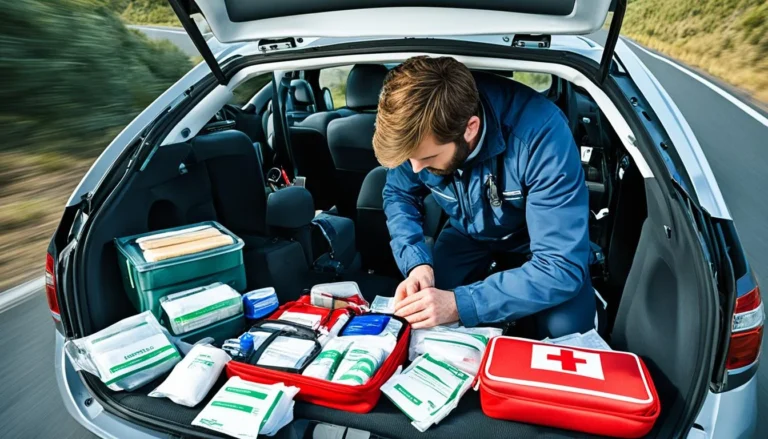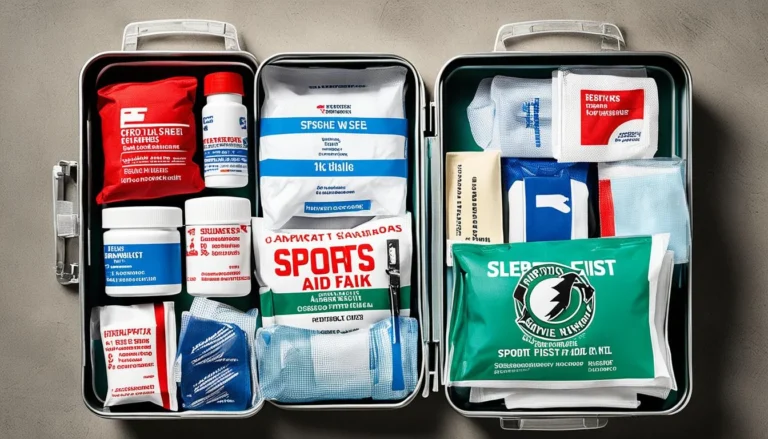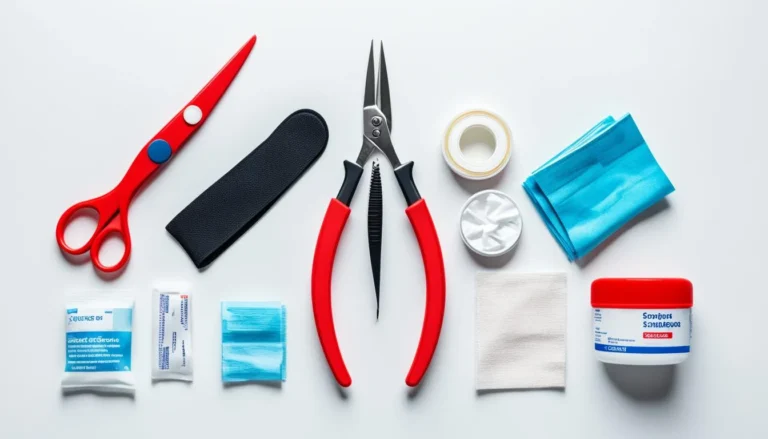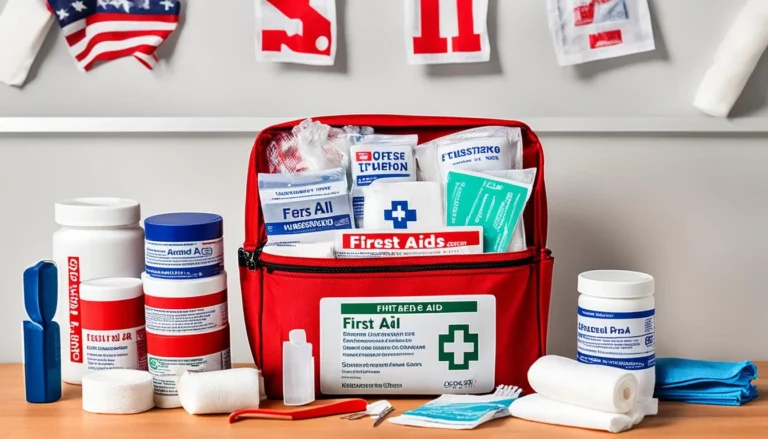Standard First Aid Box Colour Guide | UK Health Safety
A standard first aid box is key in keeping the workplace safe and ready for emergencies. In the UK, following health and safety rules is a must. Employers must make sure first aid kits are easy to find, the right colour, and close at hand. Using green for these vital kits reflects the colour’s calming effect and its ability to be seen easily in an emergency.
Green is chosen for first aid kits because it’s easy to spot and stays clear in busy emergency scenes. This choice helps avoid confusion and fear by showing clearly where first aid help is. So, a green first aid box isn’t just a rule, it’s a sign of safety in every workplace.
Key Takeaways
- The colour green in first aid boxes symbolises safety and helps to maintain tranquillity during emergencies.
- Compliance with UK health and safety standards mandates the use of green for easy identification of first aid equipment.
- Visibility and accessibility of first aid provisions are crucial components of workplace safety.
- Marking first aid boxes with a universally recognised colour supports efficient emergency response.
- Employers are responsible for ensuring first aid compliance with both health standards and practical emergency readiness.
- Green’s high contrast against most backgrounds ensures it is discernible even in high-stress situations.
Understanding the Importance of First Aid Box Accessibility
Making first aid easy to reach is key for workplace safety. By looking at how we put first aid where it can be seen and reached easily, we improve safety. This step is crucial for keeping people safe at work.
Criteria for First Aid Box Placement in Workplaces
To make workplace first aid work well, we must put first aid kits in smart places. We should choose these spots carefully after checking the workplace’s safety needs. First aid kits should be always nearby, easy to see and get to, no matter where you are in the building.
Signage and Visibility Standards for First Aid Kits
Safety signage is a big part of first aid working well. There are special signs with clear symbols that everyone should know. These signs show the way to visible first aid stations quickly when there’s an emergency.
| Location | Signage Specifications | Accessibility Notes |
|---|---|---|
| Main Corridor, Ground Floor | ISO 7010:2020 compliant, white on green | Central to all main work areas, no obstructions |
| Warehouse | Large symbols, additional lighting | Near potential hazard areas, accessible within 30 seconds |
| Office Area, Second Floor | Visible at all entry/exit points | Multiple units on floor, next to fire escape routes |
Placing first aid kits well and using safety signage right isn’t just a rule. It’s key to creating a safe work environment. By following these rules, offices can reduce harm from accidents and emergencies.
Identifying the Right Locations for First Aid Kits
Finding the right first aid kit location is key for good emergency planning. It’s crucial to ensure first aid is easily accessible. These kits need to be placed just right so they’re on hand when needed most.
- Accessibility should never be compromised by environmental challenges or obstructions.
- Kits should be positioned based on an assessment of the workplace to cover all areas evenly.
- High-traffic and high-risk areas should have more readily available first aid resources.
Here’s a guide on where to place first aid kits in different workspaces:
| Workplace Area | Consideration for Kit Placement | Reason for Location Choice |
|---|---|---|
| Main Office Floor | Central location, near the emergency exit | High traffic volume and quick access during emergencies |
| Warehouse or Factory Floor | Several evenly spaced locations | Covers lots of ground and close to where accidents may happen |
| Kitchen/Cafeteria | Near fire exits or clear wall spaces | Easy to get to, especially in a fire |
Having a solid plan for emergency and easy first aid access is critical. It not only makes the workplace safer but is also a legal must. Careful attention to workplace layout greatly boosts emergency response effectiveness. This ensures first aid is given quickly in times of need.
Assessing First Aid Kit Accessibility Through Time and Distance
When looking at first aid kit accessibility, we focus on how close they are and how quickly we can get to them. If it takes someone over 60 seconds to reach a first aid station, it’s suggested to make things better. This might mean placing more kits strategically.
The goal is to make sure first aid readiness and workplace safety are strong. First aid stations play a big part here. They hold all the needed medical items and are clear to see and get to. This way, everyone can get help quickly when needed. This improves how safe and ready a workplace is.
- Visibility: Adequately signposted stations ensure that first aid kits are easily located during an emergency.
- Accessibility: Station placement within a minute’s reach for all employees optimises emergency response capability.
- First Aid Readiness: Regularly updated supplies and clear instructional placards at each station ensure preparedness.
Checking on the system regularly keeps things getting better. It helps us stay on top of workplace safety needs and update as we face new challenges.
The Psychological Effects of Colour in Emergency Response
Colour is key in emergency readiness, affecting both safety standards and how people feel. The choice of colour in items like safety tools and signs is vital. It impacts how fast and well we react, and the emotions we feel during danger. When we consider colour psychology, using green in safety gear shows a deep understanding. It shows how colour can change our actions and feelings in an emergency.
How Colour Influences Perception During Emergencies
Colours are chosen carefully to grab our attention quickly. But not all colours work the same way for emergencies. Green stands out and is linked with safety everywhere. That’s why it’s often the top choice for things like safety signs.
The Calming Nature of Green in First Aid Contexts
Green is known for being easy to spot and soothing. This is very helpful in first aid moments, which are tense and stressful. The calm from green helps people keep a clear head and make better choices.
| Colour | Visibility | Psychological Effect | Use in Emergencies |
|---|---|---|---|
| Green | High | Calming, Reassuring | First aid boxes, safety signs |
| Red | High | Alertness, Urgency | Fire equipment, stop signs |
| Blue | Moderate | Serene, Trustworthy | Information signs, hospital wayfinding |
Knowing how colours like green affect us is key to making effective emergency spaces. Using green in safety design is a smart choice. It aims to improve both our physical reactions and how we feel in an emergency.
First Aid Box Signage Regulations in the UK
Following first aid regulations is key to make sure emergency help is easy to find and use at work in the UK. In the UK, The Health and Safety (First-Aid) Regulations 1981 state what’s needed. This helps meet the law and make first aid boxes useful in a crisis. These rules fit with wider regulatory standards for keeping workplaces safe.
Under these rules, safety signage is very important. It needs to be designed and put where it can be seen. As the HSE guidance explains, any sign showing where first aid is should have a white cross on a green background. This way, people can quickly spot where to find first aid help, making emergency help faster and better.
| Feature | Guidance |
|---|---|
| Colour | Green background with a white symbol |
| Symbol | White cross, universally known for first aid |
| Text | Clear, legible, and features the term ‘First Aid’ |
| Placement | Must be visible in all relevant areas, unobstructed |
| Compliance | Must adhere to The Health and Safety (First-Aid) Regulations 1981 |
Organisations that get these signs right not only keep to UK compliance but show they care about safety. They match their actions with important regulatory standards for protecting staff.
What Colour Is A Standard First Aid Box
The standard first aid box is a unique colour for easy spotting in emergencies. Its bright hue isn’t just easy on the eyes; it also signals safety and care needed in tough times.
Global Standardisation Efforts
The ISO green standard sets a worldwide rule for the green colour on first aid boxes. This rule makes safety procedures the same globally. It makes it easier to teach and understand emergency measures anywhere.
Historical Background of Green in First Aid
Green in emergencies has deep roots, going back to when green meant ‘safe’ in the military. This idea became stronger when the green cross marked medical areas during wars. Today, green still says ‘safe and urgent’, connecting past and present in handling crises.
| Colour Symbolism | Historical Origin | Current Usage |
|---|---|---|
| Green | Geneva Conventions medical emblem | Standard colour for first aid boxes globally |
| Blue | 19th Century naval usage for signalling | Indicates first aid in some naval contexts |
| White | Universal symbol for peace and calm | Used in hospital décor to promote tranquillity |
Maintaining Compliance with Health and Safety Regulations
In today’s work trends, sticking to health and safety rules matters a lot. It helps businesses thrive and keeps staff safe. By following rules like those from the Health and Safety (First-Aid) Regulations 1981 and using EN ISO 7010, a workspace can be both compliant and safe for everyone.
Examining The Health and Safety (First-Aid) Regulations 1981
The Health and Safety (First-Aid) Regulations 1981 are key in first aid care. They say bosses must have the right gear and people to help quickly if someone gets hurt or falls ill at work. Being compliant is more than a legal need. It shows a business cares for its team’s health and peace of mind.
The Role of EN ISO 7010 in First Aid Box Standards
EN ISO 7010 lays down the law for safety signs in work areas and public spots. It offers rules for how to make and use safety signs. When it comes to first aid signs, EN ISO 7010 makes things easier by following global safety standards. This cuts down the chance of mix-ups and accidents.
Bringing EN ISO 7010 into safety plans isn’t just about the law. It also builds a safety-first culture using clear, universal signs. This move makes sure everyone gets the workplace safety message. It makes compliance the heart of top-notch health and safety in the office space.
The Impact of Colour Visibility on Emergency Readiness
In emergency preparedness, colour visibility plays a key role. It makes spotting first aid equipment easier. This quick recognition is essential for first aid response to be fast and effective. Green, with its high visibility, is widely used, known for its safety link.
Choosing highly visible colours helps find first aid boxes quickly. This can be life-saving in emergencies. Studies have shown that reaching first aid items fast leads to quicker recoveries and less severe outcomes. Thus, the link between colour and being ready for emergencies is important.
| Feature | Impact on Emergency Readiness |
|---|---|
| High Colour Visibility | Improves speed of locating emergency tools |
| Rapid Identification | Reduces initial response time substantially |
| Strategic Colour Use | Enhances psychological readiness and reduces panic |
| Consistent Application | Fosters a standardised approach to emergency response |
Bringing these elements into the first aid kit design and placement is key. It follows the best emergency readiness guidelines. It also boosts how well people and groups can respond to health crises quickly and with effect.
Choosing Materials for Durability and Visibility of First Aid Signs
Picking the right materials for first aid signs is key to them lasting and being seen easily. Durable signs help keep safety standards up and aid in quick responses during emergencies. Options like self-adhesive vinyl and rigid plastic are popular for their flexibility and visibility in various places.
Comparing Self-Adhesive Vinyl and Rigid Plastic Signs
When picking materials for first aid signs, we look for durability and clear message delivery. Self-adhesive vinyl works well on smooth, indoor surfaces. It’s perfect for places like offices. Rigid plastic, however, lasts longer and withstands more, making it great for outdoor or tough industrial settings.
| Material Type | Benefits | Typical Use |
|---|---|---|
| Self-Adhesive Vinyl | Flexibility, easy application, cost-effective | Indoor environments, smooth surfaces |
| Rigid Plastic | High durability, weather-resistant, longer lifespan | Outdoor and industrial environments |
Understanding the Importance of Conformity to EN ISO 7010:2020
Adhering to standards like EN ISO 7010 is essential for effective safety signage. This helps keep safety communication consistent. It’s crucial for quickly spotting first aid areas in any place. Compliance boosts safety and it helps overcome language differences by using common symbols.
Getting the best materials and following EN ISO 7010 rules are big steps in making sure first aid signs are visible and reliable. This greatly helps in keeping the workplace safe and ready for any emergency.
The Vital Role of First Aid Boxes in Providing Immediate Assistance
In quick-paced workplaces, first aid boxes are key for fast medical help. They do more than store supplies. They are crucial in the first steps of helping when accidents happen.
Strategic Placement for Rapid Access in an Emergency
It’s very important to place first aid boxes just right so help comes quickly. Workplaces need to think hard about where to put them so they are easy to get to.
- Assessing potential risk areas within the work environment to determine the most beneficial locations for first aid boxes.
- Placing first aid kits near areas with higher incidence of accidents to reduce the time taken to access essential medical supplies.
- Ensuring that all employees are aware of the locations of first aid boxes, further improving the speed of response in emergencies.
Thinking about these points can help organisations improve how quickly they respond in emergencies. This means they can better protect their employees’ health.
Conclusion
In workplaces, first aid safety is always key. Choosing green for first aid boxes means they meet rules and show where to find help easily. This colour makes finding and using these critical tools fast during crises.
Knowing and following rules is vital for emergency readiness. All businesses in the UK must have first aid that follows strict health and safety laws. These steps make workplaces safer, so everyone can handle health crises well.
By including the right colours, clear signs, easy-to-find tools, and rule-following, we make first aid more effective. This mix is crucial for top-level safety and health at work. It ensures we’re ready to deal with health issues quickly and well.







